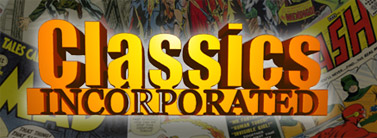GPA Article #3
Grading the Quality of Restoration
I've been using GPA's newsletter as a platform to present
my proposed modifications to the current system CGC uses in
grading restored comics. Last column I offered an expansion
of the scale used to determine the quantity of restoration,
from three categories to seven. Now let's delve into the
more abstract job of establishing a fair method to ascertain
the quality of restoration.
Judging the quality of a restorer's wares is most
difficult because it cannot be quantified. It's merit lies
within the eye of the beholder, so whoever is determining
this must have extensive experience handling restored
comics. They must have a solid idea of what lies at both
ends of the spectrum in order to create a fair benchmark.
The easiest way to establish parameters within this
spectrum is to use a classic device we're all very familiar
with. Throughout our adolescence, our achievements were
graded using the scale of A,B,C,D, and F, so it makes
perfect sense to use this same scale when grading the
quality of a restorer's work. To put it simply:
A = Outstanding
B = Excellent
C = Good
D = Fair
F = Poor
To get the ball rolling, let's give an example of what
could possibly warrant an "A" and an "F."
We start off with the teacher's pet, the perfectly
restored comic. Three things make it look spectacular. They
are, 1) the use of archival materials, 2) a great candidate
with all of the "right" defects, and 3) the perfect pairing
of the two, using techniques that are executed with years of
experience and a flair for creativity and problem solving.
To sum it up, this overachiever must appear unrestored to
earn its grade.
Then we have the precocious troublemaker, the comic
you're embarrassed to consider your own. Colors don't match,
many fixable defects are left untouched, bleedthrough and
cracking has occurred due to the use of unsafe materials
such as marker and white glue. These are the kind of comics
that are put in the corner of the display, away from the
others to avoid a scene.
Finally we have everything in the middle of these two
extremes, which is where most books will land. Here's a
quick breakdown of what each grade would represent:
A = Restoration appears near invisible, and is
even hard to spot upon close inspection. This is harder to
achieve as the extent of restoration moves into moderate and
extensive categories, so the criteria for these heavier jobs
would be perfect color matching, the most minimal use of
rice paper, and cleanings done so well that only the most
innocuous signs give it away.
B = The restoration looks great, and may appear
unrestored at arm's length, but the work is visible to those
experienced in spotting it. Most moderate and extensive
restoration jobs by known professionals should fall into
this category, simply because it's near impossible to make
such an amount of restoration appear invisible.
C = An average job by someone who maybe knows what
they are doing, and is probably using the right materials,
but doesn't have enough experience or ability to do "A" or
"B" work. This category may also apply to work done with
amateur materials, such as white glue that results in the
cover being stuck to an interior page, or a heavy cleaning
that over-whitens or causes a flimsiness to the cover and
pages. Overall, the work is obvious to most people who look
for it, but still contributes to the book's attractiveness.
D = Mostly Amateur restoration, and likely
executed with a poor choice of materials such as markers,
white glue, fixatives or bleach. The restoration has
actually caused damage to the comic; bleedthrough from color
touch, brittle paper from dangerous adhesives or chemicals,
or excessive flimsiness or cockeling from improper washing.
This work is very obvious to the point of detracting from
the appearance of the comic.
F = The most base form of repair, usually done
with techniques developed in the '60's or '70s. Examples
would be trimming, or piece replacement with typing paper
and scotch tape that is color touched with marker, and
causes heavy bleedthrough. D's and F's are typically
resubmitted for re-restoration because they sell very cheap,
and current techniques can bring about a drastic increase in
apparent grade.
The most important thing is to not confuse the quality of
work with the extent of work, or the apparent grade of the
book. Even though a certain comic may only grade a VG 4.0
with moderate restoration, it could still receive an A if
the work is near invisible. On the flip side, an apparent VF
8.0 may receive a D because the color touch is obvious from
arm's length, or a heavy washing has resulted in a flimsy
feel to the book.
Next installment we tie together the four elements of a
restored "grade"-apparent grade, quantity of work, quality
of work, materials used-to create a new, simplified system
that can be easily displayed on CGC labels. We'll also
discuss how this new system may revolutionize the restored
comic market. |
